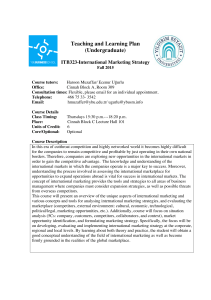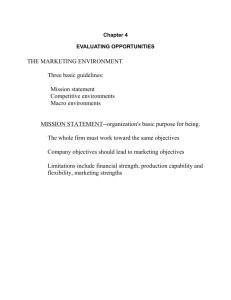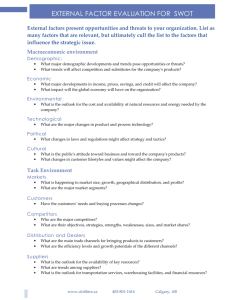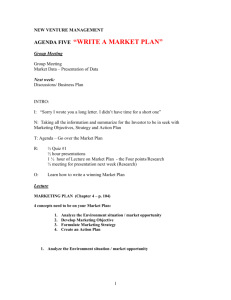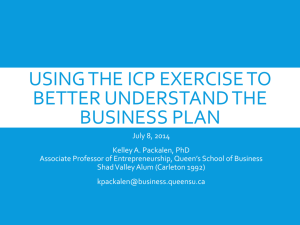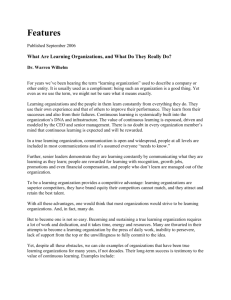mapping your company's competitive awareness
advertisement
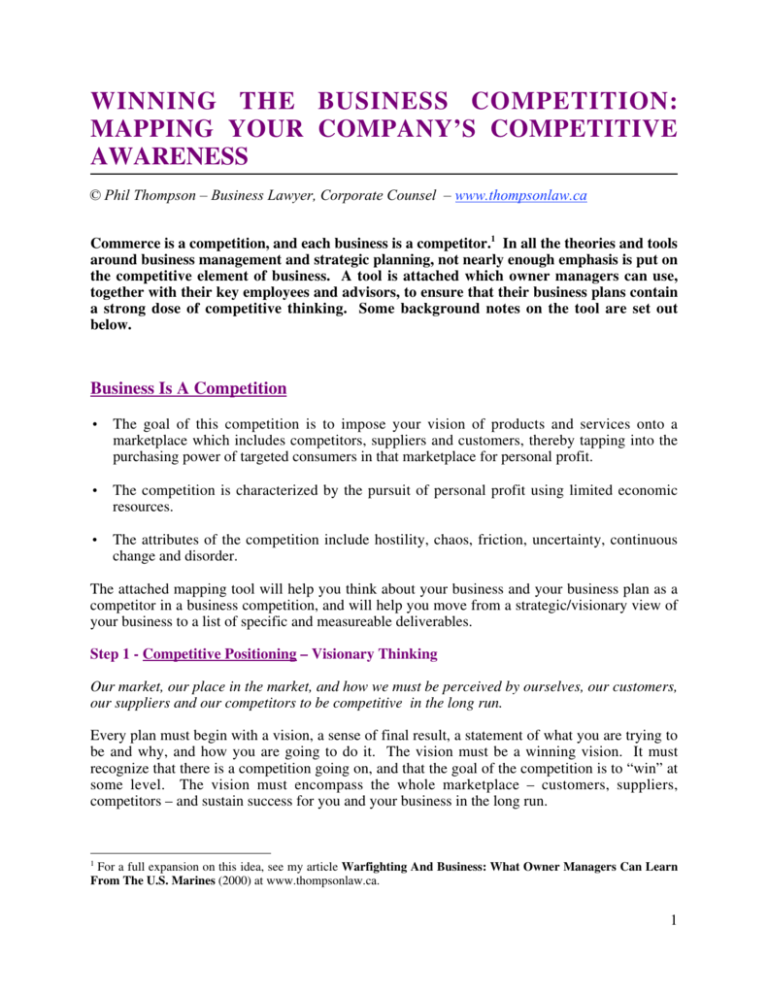
WINNING THE BUSINESS COMPETITION: MAPPING YOUR COMPANY’S COMPETITIVE AWARENESS © Phil Thompson – Business Lawyer, Corporate Counsel – www.thompsonlaw.ca Commerce is a competition, and each business is a competitor.1 In all the theories and tools around business management and strategic planning, not nearly enough emphasis is put on the competitive element of business. A tool is attached which owner managers can use, together with their key employees and advisors, to ensure that their business plans contain a strong dose of competitive thinking. Some background notes on the tool are set out below. Business Is A Competition • The goal of this competition is to impose your vision of products and services onto a marketplace which includes competitors, suppliers and customers, thereby tapping into the purchasing power of targeted consumers in that marketplace for personal profit. • The competition is characterized by the pursuit of personal profit using limited economic resources. • The attributes of the competition include hostility, chaos, friction, uncertainty, continuous change and disorder. The attached mapping tool will help you think about your business and your business plan as a competitor in a business competition, and will help you move from a strategic/visionary view of your business to a list of specific and measureable deliverables. Step 1 - Competitive Positioning – Visionary Thinking Our market, our place in the market, and how we must be perceived by ourselves, our customers, our suppliers and our competitors to be competitive in the long run. Every plan must begin with a vision, a sense of final result, a statement of what you are trying to be and why, and how you are going to do it. The vision must be a winning vision. It must recognize that there is a competition going on, and that the goal of the competition is to “win” at some level. The vision must encompass the whole marketplace – customers, suppliers, competitors – and sustain success for you and your business in the long run. 1 For a full expansion on this idea, see my article Warfighting And Business: What Owner Managers Can Learn From The U.S. Marines (2000) at www.thompsonlaw.ca. 1 Step 2 - Competitive Focus – Vision Meets Strategy What we will focus on in the near future to secure our place in the market as against our competitors. In developing competitive focus and strategic objectives, the attributes of business competition must be kept clearly in mind, including the need for personal profit and the lack of unlimited financial resources to pursue that need. All strategies must recognize the goal of controlling the competition itself by imposing your vision onto the marketplace. Seizing initiative and forcing others to react to your lead will greatly improve your chances of succeeding in the competition. In setting strategic objectives, a key understanding of weaknesses is necessary, both yours and your competitors’. Attacking their weaknesses through your strengths, while being mindful of defending your own weaknesses, tells you what to do, how to do it, and what resources you need to get the job done. That requires a frank and honest assessment of your own abilities and position in the competition. Step 3 - Competitive Success Factors – Strategy Meets Management What we must accomplish in the short run to maintain our focus and fulfill our competitive vision in our market. With competitive positioning and focus in mind, short term accomplishments must be clearly and specifically defined, and resources found and allocated to fulfill those accomplishments. “Control” is managed by setting a clear list of accomplishments and objectives in a way that fosters knowledge of what needs to be done in a broad sense as well as a winning attitude. People need know what they have to do and why, and what resources they have to get their part done, without a lot of interference in how they do it. In return for a certain degree of freedom to operate, team members must accept responsibility for their decisions and be accountable. Initiative is balanced with responsibility. Subordinates must also become responsible for “lateral coordination”. They must integrate their actions and objectives with others who are in the same chain of command. Each has knowledge of the company’s overall competitive position and focus, as well as their own competitive success factors. Rather than going up the line to get direction on how to get things done, they are expected to work together, and only go up the line if there is disagreement or misunderstanding as to focus or vision. By hiring, developing and empowering similar types of people throughout the organization, people of initiative and imagination who accept responsibility and accountability, and who are required and capable of working together, and by delegating vision objectives and not methods, owner managers can ease their own burdens, concentrate on the areas where they should be spending their energies, and can benefit from a stronger, more vibrant and more proactive organization. 2 Step 4 - Measuring Deliverables – Management Meets Strategy How we are going to know that we are achieving our objectives, maintaining our focus and fulfilling our vision. Success must be measured. Without measurement there is insufficient accountability. Without measurement, decisions to stay the course or take corrective action may be made too late in the competition. Without measurement, jumping in at the right time with the right help can not be done. Defining what to measure, when to measure, and what to do with those results, and tying it all in back in through competitive success factors, completive focus and competitive positioning – from management through strategy to vision – is essential to being and staying competitive. Competitive Awareness Blueprint These ideas can be integrated into one, simple blueprint, a copy of which is attached. By limiting the length of the document and keeping it to a simple schematic that can be studied, updated and shared as required, owner managed businesses can emphasize the idea of being in a competition in everything from top level vision to down in the trenches reporting. 3 What we will focus on in the near future to secure our place in the market as against our competitors. Our market, our place in the market, and how we must be perceived by ourselves, our customers, our suppliers and our competitors to be competitive in the long run. © Phil Thompson (2001) www.thompsonlaw.ca Competitive Focus Competitive Success Factors What we must accomplish in the short run to maintain our focus and fulfill our competitive vision in our market. Strategic Thinking Competitive Positioning Visionary Thinking How we are going to know that we are achieving our objectives, maintaining our focus and fulfilling our vision. Deliverables & Measurements For Success & Sustainability Managerial Thinking Success and sustainability in a competitive, uncertain, changing, hostile and chaotic environment. Competitive Awareness Blueprint

